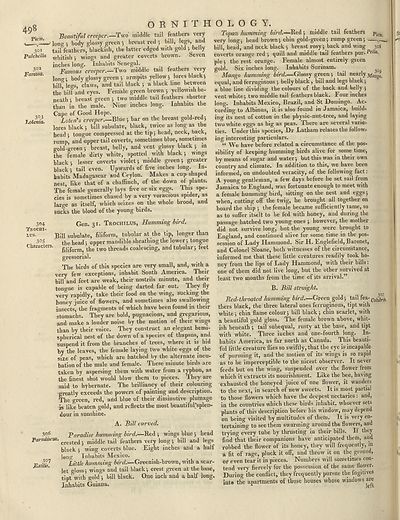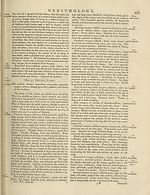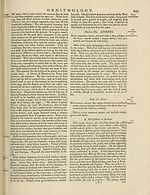Encyclopaedia Britannica > Volume 15, NIC-PAR
(552) Page 498
Download files
Complete book:
Individual page:
Thumbnail gallery: Grid view | List view

498
Piece,
O R N I T H
5®4
Tbochi-
LUS
Beautiful creeper.—Two middle tail feathers very
long 5 body glossy green ; breast red *, bill, legs, and
501 tail feathers, blackish, the latter edged with gold j belly
Pulchdla wi1jtjs|1 . wi0gs and greater coverts brown. beven
inches long. Inhabits Senegal.
Vnmnsa, Famous creeper.—Two middle tail feathers veiy
lone; body glossy green •, armpits yellow j lores black j
bill, legs, claws, and tail black; a black line between
the bill and eyes. Female green brown ; yellowish be¬
neath ; breast green ; two middle tail feathers shorter
than in the male. Nine inches long. Inhabits the
t Cape of Good Hope. ., ,
h0Jnia. Loten's creeper—Blue ; bar on the breast gold-red;
lores black; bill subulate, black, twice as long as the
head; tongue compressed at the tip; head, neck, back,
rump, and upper tail coverts, sometimes blue, sometimes
gold-green; breast, belly, and vent glossy black; in
the female dirty white, spotted with black; wings
black; lesser coverts violet; middle green; greater
black; tail even. Upwards of five inches long. In¬
habits Madagascar and Ceylon. Makes a cup shaped
nest, like that of a chaffinch, of the down ol plants.
The’female generally lays five or six eggs. This spe¬
cies is sometimes chased by a very voracious spider, as
large as itself, which seizes on the whole brood, and
sucks the blood of the young birds.
Gen. 31. Trochilus, Humming bird.
Bill subulate, filiform, tubular at the tip, longer than
u 305 tiie head • upper mandible sheathing the lower; tongue
Characters. fitiform, the tvv0 threads coalescing, and tubular; feet
gressorial.
The birds of this species are very small, and, with a
very few exceptions, inhabit South America. Their
bill and feet are weak, their nostrils minute, and then-
tongue is capable of being darted far out. They fly
very rapidly, take their food on the wing, sucking the
honey juice of flowers, and sometimes also swallowing
insects, the fragments of which have been found in their
stomachs. They are bold, pugnacious, and gregarious,
and make a louder noise by the motion of their wings
than by their voice. They construct an elegant hemi¬
spherical nest of the down of a species of thapsus, and
suspend it from the branches of trees, where it is hid
by the leaves, the female laying two white eggs of the
size of peas, which are hatched by the alternate incu¬
bation of the male and female. These minute birds are
taken by aspersing them with water from a syphon, as
the finest shot would blow them to pieces. They are
said to hybernate. The brilliancy of their colouring
greatly exceeds the powers of painting and description.
The green, red, and blue of their diminutive plumage
is like beaten gold, and reflects the most beautifursplen-
dour in sunshine.
A. Bill curved.
3°,6 Paradise humming bird.—Red ; wings blue ; head
Pamdwsfws. cregted. m;ddle tail feathers very long; bill and legs
black ; wing coverts blue. Eight inches and a half
long Inhabits Mexico.
Little humming bird.—Greenish-brown, with a scar¬
let gloss; wings and tail black; crest green at the base,
tipt with gold ; bill black. One inch and a half long.
Inhabits Guiana.
307
JZxilis.
O L O G Y.
Topa% humming i/z-r/.—-Red; middle tail feathers p;ca;i
very long; head brown; chin gold-green; rump green; ^
bill, head, and neck black ; breast rosy; back and wing 308
coverts orange red ; quill and middle tail feathers pur-
pie; the rest orange. Female almost entirely gieen
gold. Six inches long. Inhabits Surinam.
Mango humming bird.—Glossy green ; tail nearly
equal, and ferruginous ; belly black, bill and legs black;
a blue line dividing the colours of the back and belly ;
vent white; two middle tail feathers black. Four inches
long. Inhabits Mexico, Brazil, and St Domingo. Ac¬
cording to Albums, it is also found in Jamaica, build¬
ing its nest of cotton in the physic-nut-tree, and laying
two white eggs as big as peas. I here are several varie¬
ties. Under this species, Dr Eatham relates the followr
ing interesting particulars.
“ We have before related a circumstance of the pos¬
sibility of keeping humming birds alive for some time,
by means of sugar and water ; but this was in their own
country and climate. In addition to this, we have been
informed, on undoubted veracity, of the following fact.
A young gentleman, a few days before he set sail from
Jamaica to England, was fortunate enough to meet with
a female humming bird, sitting on the nest and eggs;
when, cutting off the twig, he brought all together on
board the ship ; the female became sufficiently tame, so
as to suffer itself to be fed with honey, and during the
passage hatched two young ones ; however, the mother
did not survive long, but the young were brought to
England, and continued alive for some time in the pos¬
session ot Lady Hammond. Sir H. Englefield, Baronet,
and Colonel Sloane, both witnesses of the circumstance,
informed me that these little creatures readily took ho-
jiey from the lips of Lady Hammond, with their bills,
one of them did not live long, but the other survived at
least two months from the time of its arrival.”
B. Bill straight.
Bed-throated humming bird.—Green gold; tail fea-Co/4rk
thers black, the three lateral ones ferruginous, tipt with
white; chin flame colour; bill black; chin scarlet, with
a beautiful gold gloss. The female brown above, whit¬
ish beneath ; tail subequal, rusty at the base, and tipt
with white. Three inches and one-fourth long. In¬
habits America, as far north as Canada. This beauti¬
ful little creature flies so swiftly, that the eye is incapable
of pursuing it, and the motion of its wings is so rapid
as to be imperceptible to the nicest observer. It never
feeds but on the wing, suspended over the flower from
which it extracts its nourishment. Like the bee, having
exhausted the honeyed juice of one flower, it wanders
to the next, in search of new sweets. It is most partial
to those flowers which have the deepest nectaries: and,
in the countries which these birds inhabit, whoever sets
plants of this description before his window, may depend
on being visited by multitudes of them. It is very en¬
tertaining to see them swarming around the flowers, and
trying every tube by thrusting in their bills. If they
find that their companions have anticipated them, an4
robbed the flower of its honey, they will frequently, m
a fit of rage, pluck it off, and throw it on the ground,
or even tear it in pieces. Numbers will sometimes con¬
tend very fiercely for the possession of the same flower.
During the conflict, they frequently pursue the fugitives
into the apartments of those houses whose windows are
Piece,
O R N I T H
5®4
Tbochi-
LUS
Beautiful creeper.—Two middle tail feathers very
long 5 body glossy green ; breast red *, bill, legs, and
501 tail feathers, blackish, the latter edged with gold j belly
Pulchdla wi1jtjs|1 . wi0gs and greater coverts brown. beven
inches long. Inhabits Senegal.
Vnmnsa, Famous creeper.—Two middle tail feathers veiy
lone; body glossy green •, armpits yellow j lores black j
bill, legs, claws, and tail black; a black line between
the bill and eyes. Female green brown ; yellowish be¬
neath ; breast green ; two middle tail feathers shorter
than in the male. Nine inches long. Inhabits the
t Cape of Good Hope. ., ,
h0Jnia. Loten's creeper—Blue ; bar on the breast gold-red;
lores black; bill subulate, black, twice as long as the
head; tongue compressed at the tip; head, neck, back,
rump, and upper tail coverts, sometimes blue, sometimes
gold-green; breast, belly, and vent glossy black; in
the female dirty white, spotted with black; wings
black; lesser coverts violet; middle green; greater
black; tail even. Upwards of five inches long. In¬
habits Madagascar and Ceylon. Makes a cup shaped
nest, like that of a chaffinch, of the down ol plants.
The’female generally lays five or six eggs. This spe¬
cies is sometimes chased by a very voracious spider, as
large as itself, which seizes on the whole brood, and
sucks the blood of the young birds.
Gen. 31. Trochilus, Humming bird.
Bill subulate, filiform, tubular at the tip, longer than
u 305 tiie head • upper mandible sheathing the lower; tongue
Characters. fitiform, the tvv0 threads coalescing, and tubular; feet
gressorial.
The birds of this species are very small, and, with a
very few exceptions, inhabit South America. Their
bill and feet are weak, their nostrils minute, and then-
tongue is capable of being darted far out. They fly
very rapidly, take their food on the wing, sucking the
honey juice of flowers, and sometimes also swallowing
insects, the fragments of which have been found in their
stomachs. They are bold, pugnacious, and gregarious,
and make a louder noise by the motion of their wings
than by their voice. They construct an elegant hemi¬
spherical nest of the down of a species of thapsus, and
suspend it from the branches of trees, where it is hid
by the leaves, the female laying two white eggs of the
size of peas, which are hatched by the alternate incu¬
bation of the male and female. These minute birds are
taken by aspersing them with water from a syphon, as
the finest shot would blow them to pieces. They are
said to hybernate. The brilliancy of their colouring
greatly exceeds the powers of painting and description.
The green, red, and blue of their diminutive plumage
is like beaten gold, and reflects the most beautifursplen-
dour in sunshine.
A. Bill curved.
3°,6 Paradise humming bird.—Red ; wings blue ; head
Pamdwsfws. cregted. m;ddle tail feathers very long; bill and legs
black ; wing coverts blue. Eight inches and a half
long Inhabits Mexico.
Little humming bird.—Greenish-brown, with a scar¬
let gloss; wings and tail black; crest green at the base,
tipt with gold ; bill black. One inch and a half long.
Inhabits Guiana.
307
JZxilis.
O L O G Y.
Topa% humming i/z-r/.—-Red; middle tail feathers p;ca;i
very long; head brown; chin gold-green; rump green; ^
bill, head, and neck black ; breast rosy; back and wing 308
coverts orange red ; quill and middle tail feathers pur-
pie; the rest orange. Female almost entirely gieen
gold. Six inches long. Inhabits Surinam.
Mango humming bird.—Glossy green ; tail nearly
equal, and ferruginous ; belly black, bill and legs black;
a blue line dividing the colours of the back and belly ;
vent white; two middle tail feathers black. Four inches
long. Inhabits Mexico, Brazil, and St Domingo. Ac¬
cording to Albums, it is also found in Jamaica, build¬
ing its nest of cotton in the physic-nut-tree, and laying
two white eggs as big as peas. I here are several varie¬
ties. Under this species, Dr Eatham relates the followr
ing interesting particulars.
“ We have before related a circumstance of the pos¬
sibility of keeping humming birds alive for some time,
by means of sugar and water ; but this was in their own
country and climate. In addition to this, we have been
informed, on undoubted veracity, of the following fact.
A young gentleman, a few days before he set sail from
Jamaica to England, was fortunate enough to meet with
a female humming bird, sitting on the nest and eggs;
when, cutting off the twig, he brought all together on
board the ship ; the female became sufficiently tame, so
as to suffer itself to be fed with honey, and during the
passage hatched two young ones ; however, the mother
did not survive long, but the young were brought to
England, and continued alive for some time in the pos¬
session ot Lady Hammond. Sir H. Englefield, Baronet,
and Colonel Sloane, both witnesses of the circumstance,
informed me that these little creatures readily took ho-
jiey from the lips of Lady Hammond, with their bills,
one of them did not live long, but the other survived at
least two months from the time of its arrival.”
B. Bill straight.
Bed-throated humming bird.—Green gold; tail fea-Co/4rk
thers black, the three lateral ones ferruginous, tipt with
white; chin flame colour; bill black; chin scarlet, with
a beautiful gold gloss. The female brown above, whit¬
ish beneath ; tail subequal, rusty at the base, and tipt
with white. Three inches and one-fourth long. In¬
habits America, as far north as Canada. This beauti¬
ful little creature flies so swiftly, that the eye is incapable
of pursuing it, and the motion of its wings is so rapid
as to be imperceptible to the nicest observer. It never
feeds but on the wing, suspended over the flower from
which it extracts its nourishment. Like the bee, having
exhausted the honeyed juice of one flower, it wanders
to the next, in search of new sweets. It is most partial
to those flowers which have the deepest nectaries: and,
in the countries which these birds inhabit, whoever sets
plants of this description before his window, may depend
on being visited by multitudes of them. It is very en¬
tertaining to see them swarming around the flowers, and
trying every tube by thrusting in their bills. If they
find that their companions have anticipated them, an4
robbed the flower of its honey, they will frequently, m
a fit of rage, pluck it off, and throw it on the ground,
or even tear it in pieces. Numbers will sometimes con¬
tend very fiercely for the possession of the same flower.
During the conflict, they frequently pursue the fugitives
into the apartments of those houses whose windows are
Set display mode to:
![]() Universal Viewer |
Universal Viewer | ![]() Mirador |
Large image | Transcription
Mirador |
Large image | Transcription
Images and transcriptions on this page, including medium image downloads, may be used under the Creative Commons Attribution 4.0 International Licence unless otherwise stated. ![]()
| Encyclopaedia Britannica > Encyclopaedia Britannica > Volume 15, NIC-PAR > (552) Page 498 |
|---|
| Permanent URL | https://digital.nls.uk/192588874 |
|---|
| Attribution and copyright: |
|
|---|
| Shelfmark | EB.11 |
|---|---|
| Description | Ten editions of 'Encyclopaedia Britannica', issued from 1768-1903, in 231 volumes. Originally issued in 100 weekly parts (3 volumes) between 1768 and 1771 by publishers: Colin Macfarquhar and Andrew Bell (Edinburgh); editor: William Smellie: engraver: Andrew Bell. Expanded editions in the 19th century featured more volumes and contributions from leading experts in their fields. Managed and published in Edinburgh up to the 9th edition (25 volumes, from 1875-1889); the 10th edition (1902-1903) re-issued the 9th edition, with 11 supplementary volumes. |
|---|---|
| Additional NLS resources: |
|

